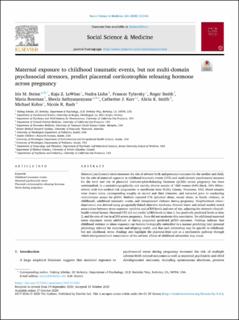| dc.contributor.author | Steine, Iris | |
| dc.contributor.author | LeWinn, Kaja Z. | |
| dc.contributor.author | Lisha, Nadra | |
| dc.contributor.author | Tylavsky, Frances | |
| dc.contributor.author | Smith, Roger | |
| dc.contributor.author | Bowman, Maria | |
| dc.contributor.author | Sathyanarayana, Sheela | |
| dc.contributor.author | Karr, Catherine J. | |
| dc.contributor.author | Smith, Alicia K. | |
| dc.contributor.author | Kobor, Michael | |
| dc.contributor.author | Bush, Nicole R. | |
| dc.date.accessioned | 2021-05-04T08:27:27Z | |
| dc.date.available | 2021-05-04T08:27:27Z | |
| dc.date.created | 2021-02-01T23:01:29Z | |
| dc.date.issued | 2020 | |
| dc.identifier.issn | 0277-9536 | |
| dc.identifier.uri | https://hdl.handle.net/11250/2753413 | |
| dc.description.abstract | Maternal psychosocial stress increases the risk of adverse birth and postnatal outcomes for the mother and child, but the role of maternal exposure to childhood traumatic events (CTE) and multi-domain psychosocial stressors for the level and rise of placental Corticotrophin-Releasing Hormone (pCRH) across pregnancy has been understudied. In a sociodemographically and racially diverse sample of 1303 women (64% Black, 36% White/others) with low-medical risk pregnancies at enrollment from Shelby County, Tennessee, USA, blood samples were drawn twice, corresponding roughly to second and third trimester, and extracted prior to conducting radioimmune assays for pCRH. Mothers reported CTE (physical abuse, sexual abuse, or family violence, in childhood), adulthood traumatic events, and interpersonal violence during pregnancy. Neighborhood crime/deprivation was derived using geospatially-linked objective databases. General linear and mixed models tested associations between stress exposure variables and pCRH levels and rate of rise, adjusting for obstetric/clinical/health related factors. Maternal CTE did not predict pCRH levels at time 1, but positively predicted levels at time 2, and the rate of rise in pCRH across pregnancy. Race did not moderate this association. No additional maternal stress exposures across adulthood or during pregnancy predicted pCRH outcomes. Findings indicate that childhood violence or abuse exposure can become biologically embedded in a manner predicting later prenatal physiology relevant for maternal and offspring health, and that such embedding may be specific to childhood, but not adulthood, stress. Findings also highlight the placental-fetal unit as a mechanistic pathway through which intergenerational transmission of the adverse effects of childhood adversities may occur. | en_US |
| dc.language.iso | eng | en_US |
| dc.publisher | Elsevier | en_US |
| dc.rights | Navngivelse 4.0 Internasjonal | * |
| dc.rights.uri | http://creativecommons.org/licenses/by/4.0/deed.no | * |
| dc.title | Maternal exposure to childhood traumatic events, but not multi-domain psychosocial stressors, predict placental corticotrophin releasing hormone across pregnancy | en_US |
| dc.type | Journal article | en_US |
| dc.type | Peer reviewed | en_US |
| dc.description.version | publishedVersion | en_US |
| dc.rights.holder | Copyright 2020 The Authors. | en_US |
| dc.source.articlenumber | 113461 | en_US |
| cristin.ispublished | true | |
| cristin.fulltext | original | |
| cristin.qualitycode | 2 | |
| dc.identifier.doi | 10.1016/j.socscimed.2020.113461 | |
| dc.identifier.cristin | 1885603 | |
| dc.source.journal | Social Science and Medicine | en_US |
| dc.identifier.citation | Social Science and Medicine. 2020, 266, 113461. | en_US |
| dc.source.volume | 266 | en_US |

